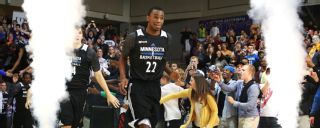|
In the 25 years of the Minnesota Timberwolves’ existence, 19 have been anchored by a big man: 12 years with Kevin Garnett, two wherein Al Jefferson and Kevin Love played together and the past four with Love. Meanwhile, their wings have been woefully -- and at times almost comically -- unathletic. Their best and/or longest-tenured 2-guards and small forwards have been shooters (Anthony Peeler, Wally Szczerbiak, Fred Hoiberg, Kevin Martin), defenders (Trenton Hassell) and even in some cases point guards in disguise (Luke Ridnour). Aside from Isaiah Rider’s three seasons with the team and Latrell Sprewell’s two, Minnesota has never had a beat-your-man-off-the-dribble-and-soar-for-a-dunk athlete who can make fans swoon. That’s about to change. With the addition of electric rookies Andrew Wiggins and Zach LaVine and the departure of Love, the Wolves have not only shifted away from an emphasis on the frontcourt but also made a quantum leap in athleticism on the perimeter. Wiggins, the No. 1 overall pick of the 2014 draft and the dowry in the August trade of Love to the Cleveland Cavaliers, may be among the most made-for-TV players in the league, the type of athlete who could one day turn snowy Minnesota and the bottom-feeding Timberwolves into a destination on your League Pass (or even national) dial. Their arrival also signals a more wide-open approach to roster building. When the Wolves got the chance to get Love in a draft-day trade for O.J. Mayo, they did, even though they already had Jefferson on the team. But a succession of moves valuing fit over talent followed: They dealt Jefferson only to pair Love with a similar player in Nikola Pekovic; they drafted Jonny Flynn instead of Stephen Curry in 2009; they took Wes Johnson instead of DeMarcus Cousins 2010. By drafting LaVine and dealing for unpolished, high-potential youngsters in Wiggins and Anthony Bennett, the Wolves seem to be at least be acknowledging the long view. “I think you have to take what’s available,” said Flip Saunders. But success is tough to define right now. Taking out the idea of what players like Wiggins or LaVine or Bennett might one day become, the offseason was one of the biggest steps back in terms of pure basketball skill the team has ever taken. Ever since Ricky Rubio came over from Europe in 2011, most of the Wolves’ moves have been of the win-now variety: hiring Rick Adelman, J.J. Barea, signing Andrei Kirilenko, taking a risk on Brandon Roy, trading for Kevin Martin, moving Derrick Williams. No matter that none of those things resulted in enough actual winning to make the playoffs; the intention was to put the right pieces around Love and Rubio and Pekovic to contend. Saunders is, of course, going to keep talking about winning, about contending. As both coach and GM, that’s his job, and when he talks about it to the media, he’s also talking about it to the players. But what are the fans going to get out of this? In spite of winning more games in each of the past three seasons, the Timberwolves’ attendance has fallen from 15th to 21st to 27th in the league. While some of this has to do with ticket price increases, it also has to do with the fact that it wasn’t a ton of fun for the average fan during the Love era. Sure, there were outlet passes and outliers, like Love’s game-winner against the Clippers and Corey Brewer’s 51-point game. But the 10th-best play of Love’s Timberwolves career is a fairly ordinary dunk -- and that’s not going to put butts in seats. The Wolves only had 17 alley-oop dunks last season; the Clippers had 169. The Wolves often played beautiful, effective basketball the past three seasons, but it was rarely exciting basketball. Based on summer league and preseason play, that shouldn’t be a problem this year. Whatever LaVine’s shortcomings as an all-around basketball player at this point, however long the road to his being a serviceable point guard at the NBA level might be (which seems to be one of the Wolves’ goals for him), he’s a Phantom Cam highlight waiting to happen. And Wiggins has shown flashes of what has been predicted for so long: strong defensive instincts, a video game-esque leaping ability, sound shooting form. He’s also looked as if he hasn’t even been trying. If you listen to the buzz, this augurs one of two things: 1.) he lacks the motor or competitive spirit to succeed at the NBA level and will perpetually underwhelm or 2.) one day he will try and the Earth will explode. We can approach what this team could or should be from a variety of angles, but the more you chop up the idea of a team identity, the less it seems to mean. Faced with the impending loss of their franchise cornerstone, the Timberwolves rolled the dice on getting as much raw athletic potential onto the team as possible. Years from now, the trade that brought Wiggins to Minnesota might look like just the stroke of good fortune the team needed, a gift. But for now, it’s just the present.
|

